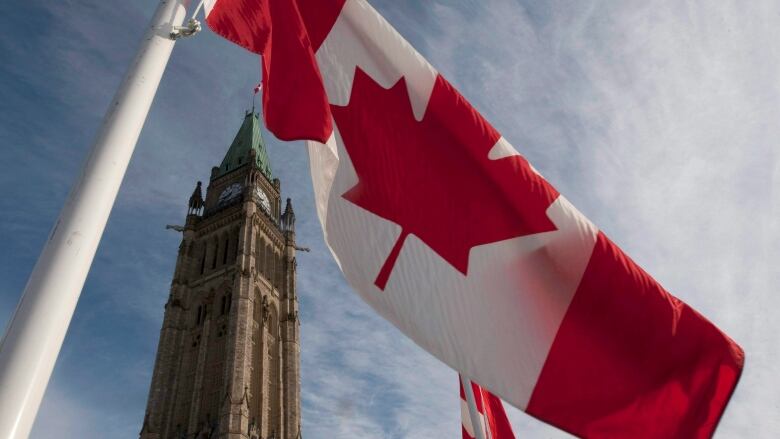Fraser Institute sounds warning on government debt
Total federal and provincial net debt equals $35,827 for every Canadian

The total net direct debt of Canada's federal and provincial governments, which now stands at almost $1.3 trillion, is a growing problem that hurts economic growth and makes less money availablefor other spending, according to a research paper by the Fraser Institute.
The Vancouver-based think-tank says the combined net debt of the federal and provincial governments has risen steadily from $834 billion in 2007/2008 just before the recessionto $1.28 trillion by 2015-2016.
- Justin Trudeau says vow to balance budget in 4 years is 'very' cast in stone
- Quebec's debt 'worryingly high,' report says
That total debt figure works out to $35,827 for every personliving in Canada a 41 per cent increase from where it stood in 2007-2008.
The Fraser Institute puts thenet federal debt (total gross debt, including pension liabilities, minus financial assets) at $692 billion for the current fiscal year. Every province except Alberta also has net debt, althoughthe institute notes that Alberta has been sliding towards a net debt position since the recession of 2008.
Growing debt
While the growth in government debt has been considerable, the institutesays the debt loadwill get larger still."Debt is poised to continue growing for the foreseeable future as several governments continue to project budgetary deficits and finance capital projects," the report says.
The report's authors argue that growing government debt is a problem because it hurts economic growth and increases the cost of paying all the interest on that debt. "Government spending on debt servicing costs results in less revenue available for important priorities such as tax relief and spending on public programs like health care, education and social services."
By way of comparison, the authors note that the $25.9 billion Ottawa will spend on debt servicing costs this fiscal year will exceed what it spends on defence ($23.9 billion) oremployment insurance ($19.3 billion).
The $60.8 billion that Ottawa and the provinces will spend on debt servicing costs this year approaches the $62.2 billion spent on public education for kindergarten through Grade 12.
10 cents on the dollar
The report says a number of Canadian governments are usingalmost 10 cents or more of every dollar in revenue to service debt obligations. In Newfoundland and Labrador, interest payments eat up 12.7 per cent of total revenue, while in Quebec, it's 10.3 per cent. The federal government, Ontario and Nova Scotia aren't far behind at about nine per cent.
"If interestratesrise, borrowing costs will rise accordingly and result in even more resources being directed to debt servicing costs," the report says.
While the Canadian government and most provinces are projecting to eliminate their deficits by 2019/2020 at the latest, the report's authors are skeptical, noting what they call the "uncertainty about whether some governments will actually achieve a balanced budgeton schedule."
The net debt-to-GDP ratio away ofmeasuringgovernment debt as a share of the economyhas risen by 22 per cent in the last eight years, according to data cited by the authors, who suggest that all governments use this year's round of budgets to "take meaningful action to address the growing debt problem in Canada."
The new Liberal government in Ottawa, despite planning to run annual $10-billion deficits, saysthe debt-to-GDP ratio willcontinue to fall, projecting the economy would grow faster than the debt.
"We will continue to decrease (the debt-to-GDP ratio) every single year because that's important for the fiscal health of our country," Prime Minister JustinTrudeau said last month.
The federal government appears to haveall but abandonedits$10-billion deficit cappledge because ofthe struggling economy, but Finance Minister Bill Morneau maintained in Decemberthat the debt-to-GDP ratio wouldstill fall, even though the Parliamentary Budget Office warned aroundthe same time that the government's fiscal outlookmay betoo optimistic.
The Fraser Institute, with its free-market and less-government-is-better philosophy, has regularly warned about the state of government indebtedness, especially in Ontario and Quebec.
Federal and provincial net debt - 2015/2016
Government Net Debt Net debt per person
Federal $692B $19,302
B.C. $40.8B $8,717
Alta. ($3.4B) ($808)
Sask. $6.7B $5,926
Manitoba $20.4B $15,793
Ontario $298.3B $21,629
Quebec $188.2B $22,769
N.B. $12.6B $16,717
N.S. $15.1B $16,032
P.E.I. $2.2B $14,868
N.L. $11.5B $21,843
Total (Fed. + Prov.) $1,284.5B $35,827
Source: Fraser Institute, Statistics Canada












_(720p).jpg)


 OFFICIAL HD MUSIC VIDEO.jpg)
.jpg)



























































































